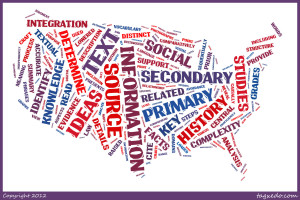 A recent Education Week blog post reported on the annual Education Writers Association conference in Nashville this week. The Common Core standards took center stage, as the writer explained: “A marathon four-hour session on the common core offered reporters the chance to hear from a range of policy experts,” though “no strident critics of the standards appeared.” Interestingly, the session didn’t delve into how educators are covering the Standards.
A recent Education Week blog post reported on the annual Education Writers Association conference in Nashville this week. The Common Core standards took center stage, as the writer explained: “A marathon four-hour session on the common core offered reporters the chance to hear from a range of policy experts,” though “no strident critics of the standards appeared.” Interestingly, the session didn’t delve into how educators are covering the Standards.
Most interesting to me was a comment by Amber Northern, the vice president for research at the Thomas B. Fordham Institute in Washington, who said, “I’d love to see an article on the top five things curriculum developers are getting wrong.”
Over the past 15 months, Learning List has reviewed hundreds of instructional materials aligned to both the Texas and Common Core state standards. Ms. Northern, here are five observations based on our experience:
(1) Some publishers seem to believe that as long as their content mentions part of a standard (i.e., the content or “noun” of the standard) the content is “aligned to” the standard.
Educators will tell you that in order to prepare students to master the standards, instructional materials must align to the content, context and cognitive demand or performance expectation of each standard.
Publishers be aware: Educators don’t give partial credit for alignment.
(2) Some publishers seem to believe that “rigorous” means “harder”. Research suggests that rigorous instructional materials:
a) Engage students with complex but grade-appropriate, complex content,
b) Require students to think critically about what they learn, and
c) Ask students to solve problems linked to the real world and their own lives.
Publishers be aware: Giving students material that is developmentally appropriate for a higher grade may be “harder,” but is not more rigorous.
(3) Some publishers comment, “Our product addresses that standard in the prior grade level.”
The instructional material for a given grade level should align to the standards for that grade level.
Publishers be aware: The alignment of the material at each grade level is judged separately. Students can’t rely solely on content they produced in a previous grade to meet an expectation in a later grade and neither should instructional materials.
(4) Some publishers seem to believe that if they “bundle” several citations (e.g., lessons, pages of text, videos) each of which partially aligns to the standard, the material is aligned to the standard.
However, the correlations don’t indicate which citations should be “bundled” to align to the standard.
Publishers be aware: Teachers expect that each citation listed in the publisher’s correlation for a standard aligns to and will help their students master the standard. For that reason, Learning List assesses citations individually for alignment to the relevant standard.
(5) Some publishers seem to believe that saying material is aligned to the standards makes it so.
Educators know when a material is and when it is not aligned to the standards.
Publishers be aware: The availability of many product options, high stakes accountability systems and tight budgets have forced educators to become increasingly critical consumers of instructional materials.
These are some of the common mistakes we’ve observed as we’ve reviewed a diverse range of instructional materials over the last year-and-a-half. But, we’ve identified positive trends* among content developers, too, as well as trends in districts’ selection practices and decisions. We’ll share those observations in future posts. Stay tuned…